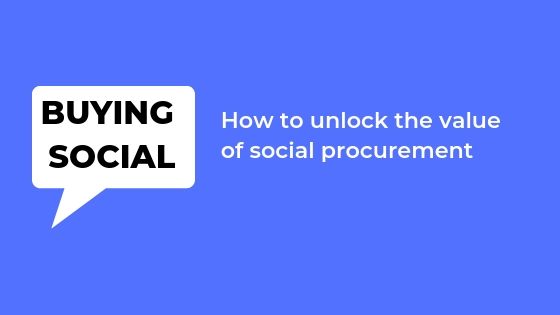Social procurement is experiencing incredible momentum with organisations across Australia. However, many organisations are yet to extract its real value.
What’s holding organisations back? And how can we take steps towards a better future of social procurement?
In part two of our Social Buying series, we explore the challenges of social procurement and practical tips to unlock its value.
(Missed part 1? Catch up on what social procurement is and why it matters)
Challenges with Social Procurement
1.Myths surrounding social enterprises and Indigenous businesses
Many myths are surrounding social enterprises and Indigenous businesses that are preventing some organisations from working with them on a more regular basis. People may think they cost more, provide lower quality products and services, or are riskier than other suppliers.
Risk is always a key concern for procurement, so this perception is something that needs to be addressed if social buying is to grow.
However, these perceptions do not reflect reality.
Solution: Buyers need to share their positive stories and real-life benefits of working with diverse businesses. Organisations also need to give suppliers the opportunity to prove their worth in the first place.
2. Not enough suppliers to meet demand
Can social enterprises and Indigenous businesses meet the demand of Australian organisations? There can be challenges finding the right social enterprises and Indigenous businesses that can respond to opportunities.
However, the great thing about smaller businesses is their ability to innovate and adapt. It’s simply easier for small businesses to change processes to meet their buyers’ needs.
Solution: Work with networks to find the right suppliers to meet your needs. Groups such as Social Traders and Supply Nation are designed to help organisations connect with diverse suppliers. The, work with the suppliers to support their ability to scale and meet growing demands.
3. A different way of thinking
No doubt about it – the focus of procurement is shifting from cost reduction to achieving value for money. However, this change is taking time, and some organisations are still some way from realising the benefits of social procurement as a value-add.
Solution:Changing a whole mindset takes work, but it can be done. Procurement professionals need to continually challenge the perceptions of what “value” means and show evidence of how social procurement can bring business benefits that range from employee retention to more loyal customers (check out these case studies on Social Traders website.)
As Social Traders managing director David Brookes said, one of the main benefits of social procurement is that it isn’t “charity, or a goodwill gesture”, but rather “a legitimate commercial arrangement”.
Actionable tips to unlock the value of social procurement
1. Set KPIs and targets.
Without targets, it can be difficult for organisations to build on their social procurement programs and get that much-needed buy-in from the wider business. Think about what you want to achieve with your social procurement spent and set up metrics to measure your progress.
Set KPIs for your procurement team too. As with any procurement policies, it takes time to embed behaviour in a team. One way to drive accountability is to agree personal KPIs.
2. Create ambassadors
Are there passionate individuals in your team who can champion social procurement? Let them lead the agenda and provide them with the support to pursue it.
3. Perform an audit
You may have more social enterprises in your supply chain than you think. Do an audit on existing spend. For example, VicRoads found that $1 million was already being spent with social enterprises and Indigenous businesses.
4. Share your successes
Continually build a business case by telling the good news about social procurement. It can be hard to measure achievements quantitatively, so create case studies and stories around the benefits your policy has created in the community.
5. Seek guidance
There are lots of networks and experts who can help you build and embed a social procurement policy. Look to these organisations and resources for help:
· Social Procurement Australasia
· Department of Aboriginal and Torres Strait Islander Partnerships
· Social Traders
· Buyability
· ArcBlue
· SupplyNation
· Victorian Government ‘Buying For Victoria’ site.
· Queensland Government ‘Consider Social Procurement’ resources
· Australia Post ‘Unlocking the value of social procurement and supplier diversity -Leading practice insights’ (2018)
Have you missed part one of our Social Buying series? Read it here.
We want to hear your stories – Have you set up a social procurement policy? What are the successes or challenges you’ve experienced?






